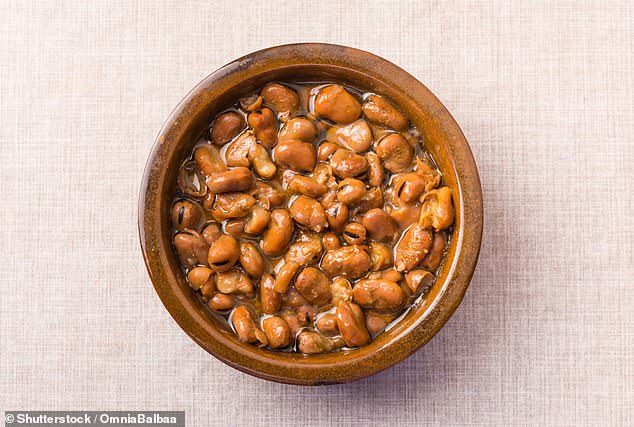Doctors reveal exactly what it means when your pee turns brown, red, green and even BLUE
If you’ve ever looked at the toilet again after going to the bathroom, you may have noticed that your urine looks lighter or darker than normal.
It is common knowledge that light-colored or clear urine is a sign that you are well hydrated, while a darker color may indicate that you need to drink more water. This is because fluids dilute the yellow pigments of the urine.
Ashley Pountney, a resident in urology at the Mayo Clinic, told DailyMail.com: ‘If you drink less, the yellow color will become stronger.’
However, your pee may not be yellow at all. Ms Pountney revealed that urine can turn brown, red, green or even blue.
Experts have revealed that your pee can turn different colors, including green, red or even blue, due to medications, food and underlying health conditions.
And while this can sometimes be because you ate too much asparagus or started taking a new medication, the changing rainbow in your toilet bowl could reveal that you’re exercising too much, have a urinary tract infection (UTI), or you may be suffering from problems such as internal bleeding or liver blockages.
‘Please note that colors may look slightly different to different people. For example, what looks red to you may look orange to someone else,” Ms Pountney said.
‘Talk to your healthcare team if you have any concerns and especially if you have painful urination or dark orange urine, which could be a sign that your liver is not working properly.’
This is what your pee says about your health.
Red or pink
Urine that is red or pink can be concerning. Ms Pountney says this is because it is a sign of haematuria, also known as urinary tract bleeding.
This is usually caused by conditions such as an enlarged prostate, kidney stones and cysts, as these problems can cause blood vessels to rupture by putting pressure on the urinary tract.
Men with an enlarged prostate – a small, walnut-shaped organ between a man’s bladder and rectum – may also have difficulty urinating, need to urinate more often or suffer from incontinence.
Kidney stones and cysts can also cause severe pain and difficulty urinating.
However, bleeding is not always a serious medical problem. Ms Pountney pointed to drugs such as Isoniazid and Rifampicin, which are used to treat tuberculosis, as they can lead to increased bleeding.
And the blood thinner Warfarin, which is taken by about 20 million Americans, also leads to an increased risk of bleeding.
Additionally, Ms. Pountney noted that not all red urine is a sign of blood. “Beets, blackberries and rhubarb can turn urine red or pink,” she said.
Orange

The pigment beta-carotene is responsible for turning carrots orange. And eating too many carrots can do the same to your urine
If your pee is orange, it could be the result of anti-inflammatory medications you are taking.
These include over-the-counter treatments such as phenazopyridine, which is sold under the brand name AZO. AZO is used to relieve the symptoms of urinary tract infections and yeast infections, which are caused by overgrowth of bacteria and fungi in the urinary tract.
This medicine contains an orange-red dye, which can change the color of the urine.
‘Drugs for constipation can turn the urine orange, as can medicines that reduce swelling and irritation, and some chemotherapy drugs for cancer,’ Ms Pountney said.
These include Sulfasalazine, which is used to treat inflammatory conditions such as ulcerative colitis and rheumatoid arthritis. Sweat and tears have also been shown to turn orange.
Additionally, supplements may be the culprit. “Some vitamins, such as A and B-12, can turn urine orange or yellow-orange,” Ms. Pountney said.
These contain beta-carotene, a pigment that makes foods like carrots orange. This means that eating a good amount of carrots can also turn your pee orange.
However, orange urine can also indicate a more serious problem. “Orange urine could be a sign of a problem with the liver or bile ducts, especially if you also have light-colored stools,” Pountney said.
‘Dehydration can also make your urine look orange.’
Blue or green
Believe it or not, your pee can turn blue and green.
Ms Pountney said dyes used in medical tests are a common cause.
A common example is methylene blue, a water-based dye used in scans and surgeries to detect conditions.
It is also used to treat methemoglobinemia, a rare blood disorder that makes it difficult for red blood cells to transport oxygen to tissues and other cells.
Common symptoms of methemoglobinemia include pale skin, fatigue, weakness, headache, nausea, vomiting, extreme drowsiness, loss of consciousness, and rapid breathing.
‘Some medications for depression, ulcers and acid reflux can turn the urine greenish-blue,’ said Ms Pountney.
These include amitriptyline, a commonly used antidepressant, Reglan, which is used to treat nausea, and Cimetidine, an over-the-counter drug for acid reflux.
Ms Pountney also noted that the rare genetic condition familial benign hypercalcemia can cause children to have blue urine.
Dark brown

Ms Pountney told DailyMail.com that eating lots of broad beans, rhubarb and aloe can darken the color of your urine
If your pee is brown, it could be a sign that you’ve been eating a lot of vegetables and legumes.
‘Eating lots of broad beans, rhubarb or aloe can cause dark brown urine,’ said Ms Pountney.
In addition, she noted that some medications, “including those used to treat and prevent malaria, constipation, high cholesterol, and seizures,” as well as antibiotics and muscle relaxants, can darken urine.
Some of the most common examples of this include the anti-seizure drug Dilantin, the over-the-counter laxative Senna, and the Parkinson’s drug Levodopa.
‘Some liver and kidney conditions and urinary tract infections can turn the urine dark brown,’ said Ms Pountney.
For example, a blockage of the bile ducts (passages that carry bile to parts of the digestive system such as the liver and gallbladder) can darken urine.
Although bleeding around the urinary tract can lead to red or pink blood, Ms. Pountney noted that internal bleeding can darken the blood to brown or cola-colored.
And if you exercise too much, it can lead to muscle injuries that cause waste to build up in the body, making your pee darker.
